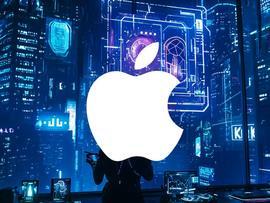Apple Earnings Preview: iPhone 17 Hopes vs. Tariff Risks
Apple is scheduled to release its fiscal Q3 2025 earnings (calendar Q2) after the U.S. market closes on July 31. In the AI era, Apple has notably lagged behind, failing to present a convincing perform

Apple is scheduled to release its fiscal Q3 2025 earnings (calendar Q2) after the U.S. market closes on July 31. In the AI era, Apple has notably lagged behind, failing to present a convincing performance to the market.
So far this year, Apple shares have declined by 13%, significantly underperforming both the broader market and its tech peers—only faring slightly better than Tesla. Its market capitalization has also fallen to third globally, now behind Nvidia and Microsoft.
The market expects Apple’s Q3 revenue to reach $88.957 billion, up 3.71% year-over-year. Earnings per share are projected at $1.42, up 1.51%. The average analyst price target is $228.
iPhone Sales Slow: New Models and AI Needed
As Apple’s flagship product, the iPhone accounts for roughly half of the company’s revenue. However, in recent years, iPhone upgrades have been lackluster. AI capabilities, though often hyped, have underwhelmed in practice. The user upgrade cycle continues to lengthen, and many consumers are switching to competing brands. iPhone revenue growth is expected to slow this quarter, with profit margins slipping.
In the critical Greater China region, Apple has underperformed the market for seven consecutive quarters. According to the China Academy of Information and Communications Technology (CAICT), iPhone shipments in mainland China fell about 9% year-over-year in the first five months of 2025. Although June sales rebounded due to e-commerce promotions and government subsidies, the “volume-for-price” strategy may erode brand value and squeeze margins.
Adding to this is nearly $900 million in additional tariffs from U.S.-China trade tensions. As a result, Apple’s gross margin is forecast to drop to around 46% this quarter.
On July 28, Apple announced it will permanently close its Apple Store in Dalian, Liaoning Province, on August 9. This marks the first time Apple has shut down a retail store in mainland China—signaling deeper challenges in the region.
More serious threats loom in Q3. With reciprocal tariff exemptions set to expire, Bank of America projects Apple could face an additional $1 billion in tariff costs, which would lower product gross margins by 50 basis points and reduce the overall margin to 45%.
iPhone 17 Set for Major Upgrade
Apple is betting on new product cycles to boost per-unit revenue. Leaks suggest the upcoming iPhone 17 will bring substantial upgrades—improved camera systems, memory, battery life, and AI functions—all designed to trigger a new wave of consumer upgrades.
Bank of America also expects Apple to release an ultra-thin iPhone “Air” model this fall, replacing the Plus version and priced $100 higher.
The launch of new MacBook Air models with M4 chips in March led the bank to raise its revenue forecast for the Mac line.
Services Growth Faces Saturation, Antitrust Pressure
Apple’s Services business is less exposed to tariff risks and boasts much higher margins than hardware. It remains Apple’s most important growth engine outside of the iPhone. However, that doesn’t mean it’s trouble-free.
User subscription rates are approaching saturation, competition is intensifying, and antitrust measures in Europe and the U.S. bring mounting uncertainty.
Bank of America forecasts low double-digit Services growth (10–13%), driven mainly by licensing, iCloud, and the App Store.
It’s worth noting that Google pays Apple over $20 billion annually for default search placement—now under threat from a U.S. Department of Justice antitrust probe. Additionally, the EU's Digital Markets Act is forcing Apple to open its ecosystem to third-party app stores, which may undercut its 30% “Apple tax.”
Tariff Threats Loom: What Will Tim Cook Do?
President Donald Trump previously declared that all iPhones sold in the U.S. must be manufactured domestically—or face at least a 25% import tariff. With tariffs potentially resuming on August 1, Apple’s leadership faces a tough challenge.
To hedge against U.S.-China trade risks, Apple is accelerating its supply chain shift to India, aiming for 60 million units of annual capacity by 2026. However, Indian factories have a product yield of just 85%, well below China's standard. High defect and rework rates, complex logistics, and increased cross-border component transport have driven up logistics costs by over 20%.
As a result, iPhones manufactured in India are significantly more expensive, putting further pressure on margins.
At this point, Apple must make a difficult decision: absorb the tariff costs and sacrifice profits, pass the costs on to consumers, or speed up its supply chain relocation. CEO Tim Cook and other top executives are expected to address these questions on the upcoming earnings call.
Disclaimer: The views in this article are from the original Creator and do not represent the views or position of Hawk Insight. The content of the article is for reference, communication and learning only, and does not constitute investment advice. If it involves copyright issues, please contact us for deletion.